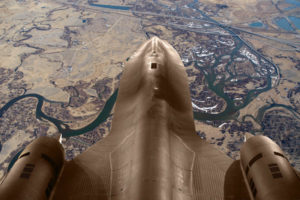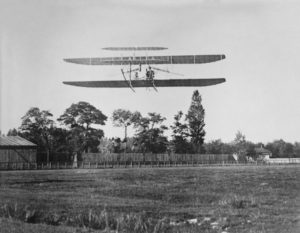What does it really take to fly a plane? Is it a gift only bestowed upon a chosen few or is it a skill that can be achieved by anyone?

Image Travel 3Sixty
Since time immemorial, humans have been intrigued with flying, and nothing idealises this better than the famous Greek myth about Icarus, who flew too close to the sun. Icarus and his father were imprisoned on the island of Crete by the Minotaur, a creature half-man half-bull. In order to escape, Icarus’ father, a skilled craftsman, created a set of wings made of feathers and wax for each of them. He warned his son of the danger of flying too high as the sun’s scorching rays would melt the wax. However, once they took flight, the young man’s desire to fly high in the sky overcame all reason, and as he rose higher and higher, Icarus’ wings melted and he fell to his doom below. The place where he fell in the Mediterranean Sea came to be known as the Icarian Sea.
Time has not dimmed the human dream to soar through the sky, and a little more than a century ago, that dream finally became a reality when the Wright brothers invented the first powered and controlled airplane in 1903. Up to that moment, ‘heavier than air flying machines’ were believed to be impossible. Orville Wright made the first flight, 20 feet above a wind-swept beach in North Carolina, which lasted 12 seconds and covered a distance of 120 feet. Orville’s brother Wilbur then made three more flights that same day, and their record flight lasted 59 seconds over a distance of 852 feet.
Ever since that historic flight by the Wright brothers, these heavier-than-air machines have continued to advance in leaps and bounds, flying both people and goods all around the world. Today, the aviation industry boasts of airborne marvels such as the Blackbird (SR71) that can fly three times the speed of sound, and the Airbus A380 that can carry more than 800 passengers non-stop halfway round the world!

Image Travel 3Sixty
The impressive Blackbird SR-71, which is said to be the fastest plane ever flown, had its first test flight in 1964.
What was once regarded as impossible is now a regular feature in transportation in the modern world. So, is it really difficult to fly a plane? The answer actually hinges on one’s perception of flying – whether flying a plane is viewed as an elusive talent, or a routine task whereby the skills can be acquired, much like driving a car. A normal passenger may find an airborne piece of metal with its maze of buttons and switches in the cockpit totally baffling. On the other hand, others might simply think of flying a plane as no more difficult than any other profession, where the necessary know-how can be learned.
HONING THE CRAFT
When I started flying in the United Kingdom, I found that it wasn’t as easy as I had initially expected. I realised that my British counterparts were far ahead in terms of aviation knowledge as they had been regularly exposed to the allure of the flying heroes of WWII and the Battle of Britain (as evidenced by the numerous old RAF airfields scattered all over the country, which incidentally served as a good place to practise emergency landings).
However, as I eventually mastered the skills required to fly a plane and earned my wings, I found flying to be both enjoyable and liberating.
During a flight, the process of flying in itself is not inherently difficult, but it is often inundated with additional tasks like communicating with the control tower or crew, setting the engine power, maintaining the altitude when flying without automation during an emergency, and other procedural aspects that, quite frankly, can take away from the simple delight of being airborne. A pilot also needs to be constantly alert of the surroundings (situational awareness) while maintaining focus, so that he or she is able to make proper judgments and ensure an enjoyable and safe flight. It helps to get the basics right from the get-go, so training is crucial and flight instructors also play a vital role. All teachers have the ability to either ignite or dampen their students’ talent and passion, and flight instructors are no exception, as they can either make or break a person’s flying career.

Image Travel 3Sixty
The aviation industry today owes much to the Wright brothers who were the first to design and build a craft that could be controlled in the air. Pictured here is an early Wright aircraft, circa 1908-11.
SPATIAL DISORIENTATION
The simple truth is: humans are not made to fly. This means that some of our senses, such as our ability to gauge if we are flying upside down in the absence of visual cues, are practically useless when we are in the air. For instance, when the aircraft is engulfed in a cloud, our senses may tell u that we are still flying straight up while the flight instruments indicate a totally different story!
This is no different from when you are in a train and the adjacent train starts moving forward… you experience a false illusion that your train has started moving in the opposite direction. Your senses tell you that you are moving, but a technical instrument such as a speedometer shows that you haven’t moved an inch! To counter this error of sensory perception, pilots are trained to trust and fly on the aircraft’s flight instruments.
GOLDEN RULE
It goes without saying that although flying is not on its own difficult or dangerous, it is unforgiving of carelessness, incapacity or neglect on the part of ‘the person behind the wheel’. To avoid such shortcomings, airline pilots undergo intense training, whereby it is imperative for them to understand the technicalities of the aircraft well. The hydraulics, electrical, navigational and other systems must be mastered before a pilot is allowed to fly a plane. Every pilot is also equipped with the necessary expertise to respond to emergencies; and the golden rule is: aviate, navigate and communicate. In line with this rule, the pilot must first continue flying the aircraft, and then, ascertain the location of the aircraft, as well as the direction it is heading. Once the pilot has successfully completed these two stages, he or she then needs to make contact with the control tower to inform them of the situation at hand.
THE QUESTION, ANSWERED
Some are of the opinion that flying is nothing but endless hours of boredom with possible periods of great stress. The passion that pilots have for their jobs can only be explained by their thrill of flying and the occasional adrenaline pumping moments they experience in the air. So ultimately, considering the various facets of flying, the answer to the question, “Is it really difficult to fly a plane?” is yes – it can be difficult at times to fly a plane. However, just like any other skill, thorough and rigorous training in every essential aspect of flying makes it a safe and enjoyable endeavour. After all, it is our job to make you feel that you are always in safe, capable hands.
Sunday, 12 February 2017 15:12